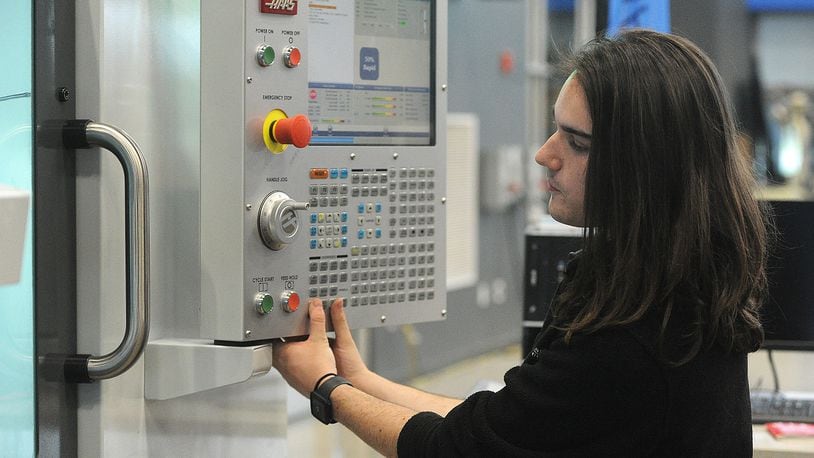As enrollment expands, the career tech centers say they need more space and more equipment to teach the students. The state allocated $200 million for facilities and $100 million for machinery and equipment in the state during the 2023-2024 fiscal year.
Why career tech?
Students at these career tech centers cite a range of reasons as to why they chose to attend, from wanting a certification to take directly into the workforce to plans to go to college based on the work they’re doing in school now.
“We want more people to graduate career-ready,” said Lt. Gov. Jon Husted, who has been advocating for career tech schools and expansion. “Right now in Ohio, we have more jobs than people to fill them.”
Ohio is expanding manufacturing jobs with the addition of a Honda plant in Fayette County, Joby Aviation’s factory planned for close to the Dayton airport, and the Intel factory planned in Licking County. Many of the jobs that would be required with those expansions would require certifications in specialties like HVAC and electricians.
More traditional jobs have also been impacted. Hospitals, schools and public safety departments have said for years they are struggling to find staff. The career centers work directly with businesses to get students into those jobs.
For example, Kettering’s Fairmont High School, which has its own career tech program to train state-tested nursing assistants — STNAs — trains juniors before they take the test to become certified. Their senior year, the students are out working, said Liz Jensen, Fairmont’s career tech principal.
Credit: JIM NOELKER
Credit: JIM NOELKER
Those students then have a career for post-high school but if they choose, they can also earn a licensed practical nursing degree or a registered nurse degree.
Dee Smith, executive director for the Ohio Association for Career Technical Education, said there’s been an uptick in the number of students attending career tech centers for several years. She said the rising costs of college have many families thinking about ways for students to achieve their goals without paying for it right out of high school.
Students who walk out with a credential from a career tech school can go to work for a company that offers tuition reimbursement. Those students then don’t have to pay for their own college, Smith said.
“The tuition has risen to a point where it doesn’t make sense for them to pursue that bachelor’s degree or higher for the job that they’re going to have for the next five years when they come out,” Smith said.
That doesn’t mean that all students should be in career tech. Smith said there are always going to be jobs that require higher education.
But for many students, especially those who want to go into engineering or health care, career tech education can give them a head start.
Corinne Gill, a junior at the Greene County Career Center, said she’s interested in engineering in the future. Being at the career tech center gave her an opportunity to do hands-on work that applies to her future, she said.
Kaden Gillespie, a Greene County Career Center student, said he came to the career center because he didn’t want to go to college, but wanted to work with robotics.
He said he likes hands-on work because that’s how he feels he learns best. He also said he’s already gotten offers for jobs because of the work he’s done at the career tech center.
“It’s about creativity and doing stuff,” he said.
The career centers are required by law to have advisory boards with local businesses on them. Those local businesses often get their pick of students because they interact with them frequently.
Demographic shifts
Manufacturing, construction and hospitals are also struggling in part because the Baby Boomer generation, born in 1946 to 1964, are retiring. The Census Bureau estimates roughly 73 million people are in this generation. The only generation the Census Bureau says is bigger are millennials, which it defines as those born from 1982 to 2000, and is estimated at about 83 million people. This isn’t expected to change, and the number of older adults is expected to outnumber children by 2034.
That means those entering the workforce have an advantage, especially those with credentials that match what companies want.
Ohio also didn’t invest in career tech while many millennials were in high school and encouraged college attainment over going into a trade.
To prepare high school students, the state is now investing heavily in career centers. The state has announced several rounds of funding, which will directly benefit multiple local career centers.
But while career tech is booming right now, it also can’t fully solve the workforce crisis. In some workplaces, the demand is higher than what a career tech center can provide.
Husted said the demographic shifts are a developed nation problem — Ohio is not the only state in the country having this problem, and the U.S. is one of many nations that are growing older — but he said he hopes as Ohio grows, it will attract people back who have left.
“It’s a demographic issue, but first, our responsibility is to take care of Ohioans and then we hope secondarily, to get maybe your children or grandchildren to move back home and take all the extra jobs that were created,” Husted said.
About the Author
